The Power Of Solitude:
Anatoly Krynsky – A Life For Art
By Gaither Stewart
August 2000
| Solitary,
lonely and just a bit amused, the men of stone
observe the sad scene being played out under their
eyes. The truncated little statues sit on an overhead
shelf as mute spectators of the devilry of the
bizarre clown dancing to the silent beat of a dreamy
drum and a murky balalaika. The seven figures crowd
the tight space of the engraving - the dominant
clown, two miniature musicians and the four stone
observers above. Lonely stone men they are, images of
the silent statues standing in front of the Nature
Institute in the artist’s native Kharkov. They
are brothers of the thousands of mysterious 7th
century statues abandoned over the endless steppes of
southern Siberia and in the former Ukrainian homeland
of the New York artist Anatoly Krynsky. Krynsky’s “World of Dolls” series is not what it might sound like. Hardly the thing for the walls of a little girl’s bedroom, its images are, yes, magic and magical. But also dark and strange. |
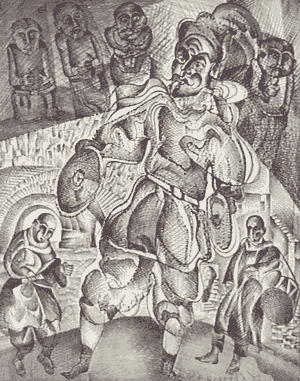 "World of
the Dolls" series/"Shaman" |
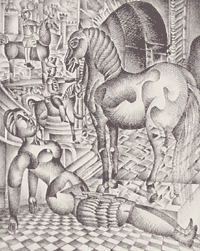 "World of
the Dolls" Series |
Each
of the solitary figures in the enigmatic engraving
spread on the table of his Manhattan studio expresses
the same solitude and loneliness of other subjects
populating the paintings and engravings of the
collection. If you observe and compare “World of
Dolls,” you can see in them the same solitude
and the same loneliness of the Spaniard facing the
French firing squad in Goya’s “3 May
1808.” It’s the solitude and loneliness and
despair in Dürer’s famous engraving,
“Melencolia I.” The one-half ton etching press stands like a gentle but invasive elephant in the center of the crowded studio of Maestro Anatoly Krynsky on the backside of his darkened top-floor apartment on New York’s Upper East Side. |
| The
bemused artist gazes at the iron giant fondly.
Fatalistically he shrugs at the suggestion that it
might crash through to lower floors and provoke a
progressive collapse of the old building under the
shadow of the Mount Sinai Hospital. The press, he
says, has after all not wavered nor the floor even
trembled through the 24 years since he arrived here
from the then repressive – permissive Moscow. The artist caresses the pampered Pelikan Etching Press. It occurs to me that the giant is emblematic of Krynsky’s life for art. For even if the Maestro prints limited copies of each etching and then paints on top of them so that each is a unique work, his art world is nonetheless so vast as to be illimitable – Krynsky’s art is total art. |
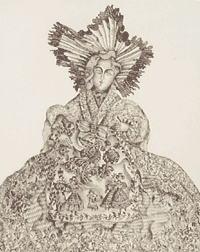 "World of
the Dolls" Series/"Pretty Doll" |
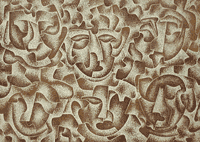 "Face to Face" Series 1991; 20" x 28"; Color Print |
The visitor looks around the studio space bewildered, at first with unseeing eyes as when you seek one face in a crowded bus, until then the objects separate and each assumes its own distinctiveness. Miraculously order emerges from confusion. Each object plays a role and seems to mark the diverse stages of his life – a New England chair from a Vermont ski trip, an antique desk from a Long Island garage sale, a wooden file cabinet on whose doors the artist has painted scenes of his beloved centaurs, a paint-smeared easel dating back to his Kharkov days, a miniature bronze tiger from a trek through Siberia, a Tyrolean wall clock from his stay in Italy, a Novgorod icon from his private collection. And here and there on the totally covered studio walls – a heavy relief in sand, an oil painting of Central Park, an engraving of magical Stonehenge. |
| As your vision broadens, the dream-like figures of the centaurs, contorted and enigmatic, emerge omnipresent, leaping and romping and prancing throughout the studio and up and down the dark corridors of the apartment, from cabinet doors in the kitchen, to closet doors in a bedroom, to panels in the madness of the Boa Constrictor – computer room. The centaurs create a sense of timelessness. Unpredictability reigns. Greece and Rome compete with Moscow and New York. In perpetual movement, the | 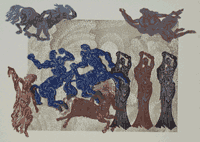 "Centauriad" |
| centaurs appear like countless film frames that somewhere fit together to produce the artist’s art ideal. The essence of his art. What does the centaur mean, you wonder? It is a mystery. An alluring mystery. The artist does not say what it means. Again he shrugs. He tells you only that he began painting the centaurs in the 1960s in Moscow in protest against the reigning official art of Socialist Realism. |
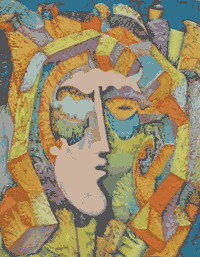 "Princess" 1981; 17" x 22"; Color print |
“The
centaur has long been a special theme in my work. I
have executed centaurs in various materials – in
sculptures, reliefs, paintings and graphics - which
has allowed me with each passing year to diversify
them and to delve more deeply into this enchanting
world of ancient mythology.” You have to be satisfied with that. That is all he ventures. But the zenith of the contemporary popularity of his centaurs must have been Krynsky’s retrospective exhibit in the U.S. Senate in Washington, D.C. some ten years ago in which the centaurs starred - dancing and swaying and straining toward the expression of his total art. The essence of his art seems to lie somewhere in the lonely image of the prancing centaur depicted on a Senate painting or on a kitchen cabinet door. |
| One
comes to understand also that the man himself is to
be sought chiefly in his art since it synonymous with
his life. You find more answers about the artist in
his centaurs than in his opinions about national
politics or international events. Nonetheless, you still wonder. Who is this man - Anatoly Krynsky? From what planet did he descend? Is he Mask or is he Man under one of his own masks? You learn little by asking the artist’s opinions or about his likes and dislikes or about his former teachers or the influence of other artists. He anyway prefers to speak of Buddhism and Tibetan medicine or the mystery of Stonehenge and Aztec pyramids. |
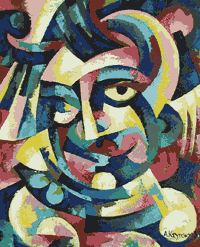 "Face to
Face" Series/"Clown" |
| “It’s useless to talk about my early years except for the short period after I met in Kharkov the famous Constructivist, Vassily Yermilov and the Russian vanguard artist, Boris Kotare. They revolutionized my artistic awareness. Until that time I had blindly copied nature or simply executed my daily etudes, without any understanding of their true significance.” |
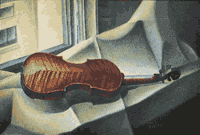 "Still Life" Series/"Violin by Window" 1986; 32" x 48"; Tempera on Canvas |
Anatoly Krynsky has been erroneously labeled a Constructivist. The definition is much too limiting of the complete artist who instead already as a young man pressed ahead from his early works of the period he studied under Yermilov in the Kharkov Art Institute, to themes like Man and the City or the Duality of Man and of Life, works already then depicted in his Cubofuturistic - iconographic style. Like a cyclone he passed through subsequent periods, carrying over from each period something to the next. |
| His
was an art on-the-run marked by a cycle of masks
linked to ancient Egypt, by long years of experiments
with reliefs based on the use of sand, paints and
metal, by advanced studies of the nature morte as a
link with antiquity, and even by Italian landscapes
painted for his exhibits in Bologna and Rome in the
1970s. Through all the phases and cycles and series of his art and through two emigrations – first from his native Kharkov to Moscow and then from Moscow to New York - Krynsky has continued to devote his major attention to oil painting. His recent exhibit in a New York gallery was dedicated wholly to major oil paintings of Manhattan’s Central Park. |
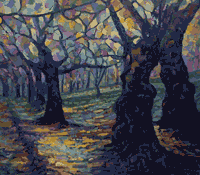 "Mystery of Central Park" Series "Old Bole" 1997; 36" x 40" |
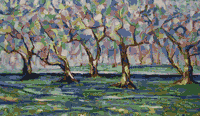 "Mystery of
Central Park" Series |
“I’ve lived my New York years just next to Central Park and couldn’t remain indifferent to it. I’ve devoted much time and many paintings to its trees and flowers. Especially the Japanese Cherry trees excite me – the wonderful whimsicality of their trunks. And how beautiful when they bloom each spring when the park explodes in color – the magnolias and Wild Apple trees and the leaning trees around Belvedere Lake.” |
| Yet
despite such entertaining subjects as passages and
nature, he is the artist forever in search of the
face under the mask as exemplified by a series of
works under the general name FACE inspired by his
weekly visits to the Metropolitan Museum and
especially the Egyptian section of the Metropolitan
Museum of Art. “Likewise clowns have always fascinated me - the colorfulness and unusual inventiveness of these magic people favoring us with their sad and lonely smiles. Likewise the image of The King, so alone, so lonely, so mysterious.” |
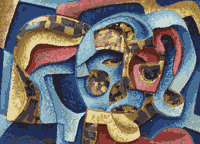 "Relief" Series/"Jester" 1988; 22" x 30"; Sand, Mixed Technique |
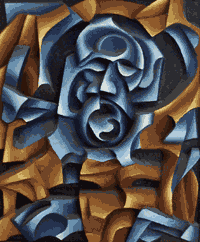 "Reliefs" Series/"Old Man" 1988; 24" x 28"; Sand, Mixed Technique |
And
then, from time to time and on the master’s
orders, the faithful Etching Pelikan Press turns out
engravings - judiciously, stingily, as if to withhold
the silent originals - now the Stonehenge cycle, now
his reworking of his earliest drawings of the face of
a woman or a child. He says that the technique of
etching of the objects that surround him has helped
him attain the degree of expressiveness he needs. “Yet once they are committed to the canvas or the press, my subjects seem to abandon me. They can never again be retrieved. And I know that I too must abandon them. If the subjects in ‘The World of Dolls’” have abandoned me, I also have abandoned my subjects. Those silent stone figures now stand there alone as they have for centuries. |
| “That’s
double loneliness. Once they were united, creator and
subject, in the Eden of the my fantasy. But after the
act of creation they are destined to be forever
separate, proud and independent like man vis-à-vis
God – yet lonely and longing for reunion.” Dürer’s winged genius too sits in a reflective pose surrounded by various tools – a compass, scales, an hourglass and a magic square of 16 numbers, each row of which totals 34. The desperate artist languishes under the observation of a dog, a cherub and a bat holding the inscription “Melencolia I.” |
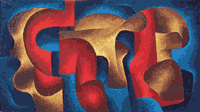 "Blue and Red" Series/"Man and Woman" 1980; 34" x 64"; Oil on Canvas |
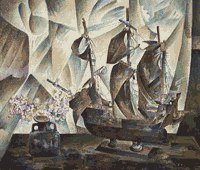 "Still Life" Series/"Ship with Venetian Vase" 34" x 40"; Tempera on Canvas |
If the meaning of Dürer’s work is uncertain, you might sense that the interpretation concerns the relationship between melancholy and creativity: the conclusion is that melancholy is essential to creativity. For what greater melancholy than that in the couple in Picasso’s “The Frugal Meal” – the haggard man with an arm draped around the bony shoulders of his woman companion, each looking in opposite directions, each alone in their common solitude. Hopeless yet assailed by nostalgia - Picasso’s natural nostalgia for another existence. A nostalgia that leads the artist back to his natural loneliness - for one thing he knows: he knows where creativity resides. |
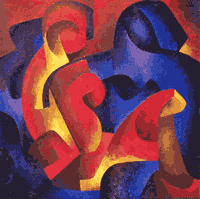 Man and Woman 1982; 48' x 48"; Oil on Canvas |
From
Goya’s deafness and exile like from
Dürer’s meditation in “Melencolia I”
emerges a formula:
solitude>melancholy>desperation>inspiration>originality>creativity.
But also the converse is suggested: sociability>enjoyment>exhilaration>fashion>imitation>non-creativity. Krynsky: “I know - I think it’s instinctive - that I need that solitude. Somehow I know that truth lives there.” No less than the mature Goya of “3 May 1808”! Aloof, lonely and depressed in his deafness, Goya has acquired total freedom and can now follow every caprice of his imagination to express himself - not the dictates of fashion. His freedom and expression are nurtured in his solitude, in his isolation and melancholy. |
Krynsky’s summarization is instead reductive and disconcerting: “For the ‘World of Dolls’ series I am also indebted to my daughter’s extraordinarily big collection of dolls and decided to fix in time some of these dolls and the magic world of children’s imagination.”
Yet, in Krynsky’s works the solitude of the clowns of his “Clownad” series and of all those ancient statues seem to exude the mystery of eternity. The menhirs and dolmens of Stonehenge and Carnac, the sculpted Mayan and Olmec deities and the Polevetskiye Women of the Ukraine, the stone sculptures of Siberia and the Stoanere Mandlin - the stone men - of Tyrolean regions and the silent men of stone in Anatoly Krynsky’s “The World of Dolls” again appear to us as the inner side of the artist’s perception.
Ironically Krynsky’s certain economic success in the 1960s and 70s of the former Soviet Union also changed his life in a fundamental manner. As an illustrator for magazines like MOLODAYA GVARDIA and KRUGOZOR, for the APN Press Agency and as an “official artist” on a variety of state art projects he, like many artists and writers of the period, enjoyed a relative material success. “That might seem positive but the reality was that I had no time for my own art. Therefore I decided on the most decisive step in my life – emigration with my wife and daughter to the United States.
“My first emigration however,” he explains, “was no easier than my emigration to the USA. Those familiar with the Soviet Union will understand how difficult it was then to move from Kharkov to Moscow. I had to legally divorce my wife and contract a fictitious marriage just to get a residence permit in Moscow.
“In a similar manner, although I’ve been a professional artist for forty years, I still feel like an explorer in the world of art, which I believe is evident in all my works. And explorers are by nature and choice solitary and lonely people. Each must find his own path to self-expression, his own character, his own style. On that path he experiences all the difficulties and all the joys. Some succeed. Some fall into oblivion. I believe that that lonely search is the basis of every creative person. I’ve always had my calling as an artist - explorer to help me.”
The body of Anatoly Krynsky’s works attests his loyalty to Byzantine spiritualism which however he exalts with a new voice and achieves unexpected openings toward Western culture. He has been able to transfigure Eastern mysticism within the polyphonic richness of Europe. His work demonstrates that art is the kingdom of a freedom that must discipline itself so as not to degenerate into anarchy. His dancing centaurs are not pure lyrical emotion and inspiration. Little or nothing is left to chance here no more than in his earlier Constructivist and Cubist works.
“Some of these paintings might appear to be tumult and chaos,” Krynsky says, “but I assure you it’s not at all. For above all I love the rule that corrects emotion.”
Alone there with his Pelikan etching press, and among his centaurs and masks and kings and lonely dolls and sand reliefs and Central Park trees and Russian icons, Krynsky comes to resemble his subjects. He too laments and complains that he is always alone. “Yet,’ he admits, “I need that solitude in the search for truth in my work. For I know that truth lives there.”
For more information on Anatoly Krynsky, go to his website at: www.anatolykrynsky.com
He can be reached at pkrynsky@stny.rr.com
Gaither Stewart can be reached at 110715.505@compuserve.com
